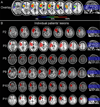Specifying the role of the left prefrontal cortex in word selection
- PMID: 26291289
- PMCID: PMC4712683
- DOI: 10.1016/j.bandl.2015.07.007
Specifying the role of the left prefrontal cortex in word selection
Abstract
Word selection allows us to choose words during language production. This is often viewed as a competitive process wherein a lexical representation is retrieved among semantically-related alternatives. The left prefrontal cortex (LPFC) is thought to help overcome competition for word selection through top-down control. However, whether the LPFC is always necessary for word selection remains unclear. We tested 6 LPFC-injured patients and controls in two picture naming paradigms varying in terms of item repetition. Both paradigms elicited the expected semantic interference effects (SIE), reflecting interference caused by semantically-related representations in word selection. However, LPFC patients as a group showed a larger SIE than controls only in the paradigm involving item repetition. We argue that item repetition increases interference caused by semantically-related alternatives, resulting in increased LPFC-dependent cognitive control demands. The remaining network of brain regions associated with word selection appears to be sufficient when items are not repeated.
Keywords: Chronic stroke patients; Language production; Left prefrontal cortex; Proactive control; Semantic interference; Word selection.
Copyright © 2015 Elsevier Inc. All rights reserved.
Conflict of interest statement
We declare that the research reported here was conducted in the absence of any commercial or financial relationships that could be construed as a potential conflict of interest.
Figures




References
-
- Alario F-X, Chainay H, Lehericy S, Cohen L. The role of the supplementary motor area (SMA) in word production. Brain Research. 2006;1076(1):129–143. - PubMed
-
- Alario FX, del Prado Martín FM. On the origin of the “cumulative semantic inhibition” effect. Memory & cognition. 2010;38(1):57–66. - PubMed
-
- Aristei S, Melinger A, Abdel Rahman R. Electrophysiological chronometry of semantic context effects in language production. Journal of Cognitive Neuroscience. 2011;23(7):1567–1586. - PubMed
-
- Baayen RH, Davidson DJ, Bates DM. Mixed-effects modeling with crossed random effects for subjects and items. Journal of Memory and Language. 2008;59(4):390–412.
Publication types
MeSH terms
Grants and funding
LinkOut - more resources
Full Text Sources
Other Literature Sources

